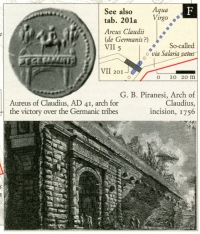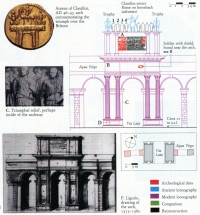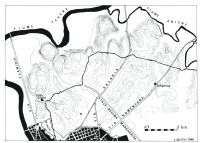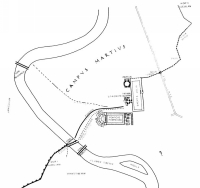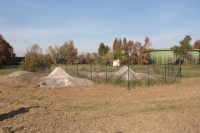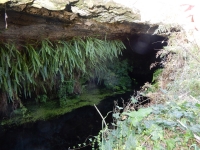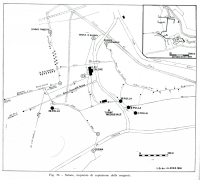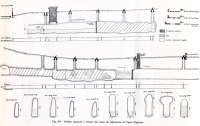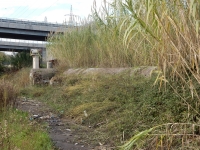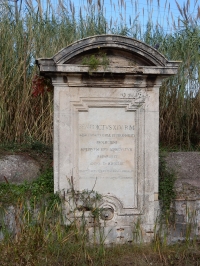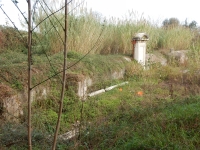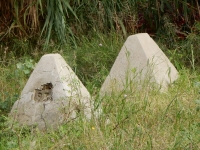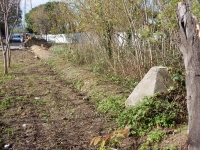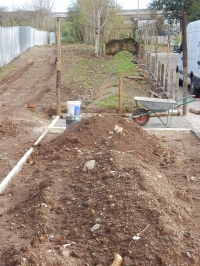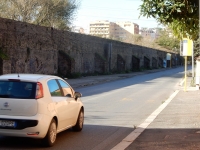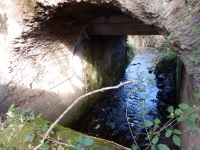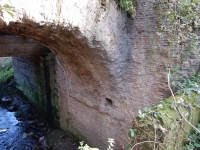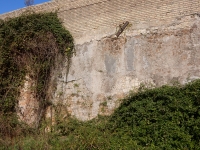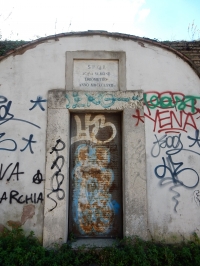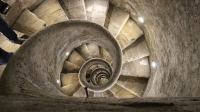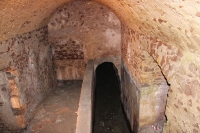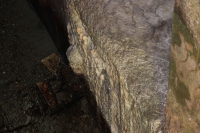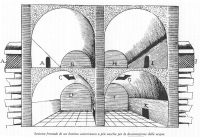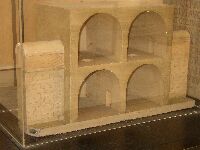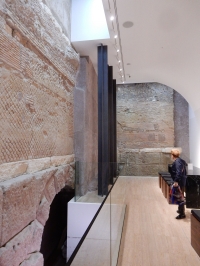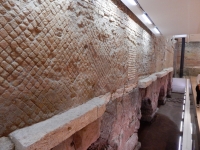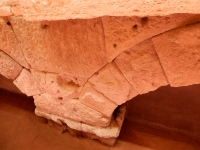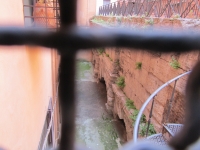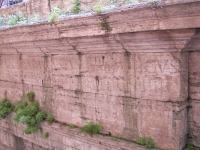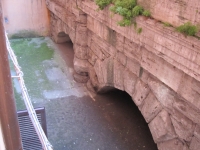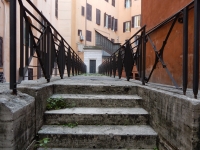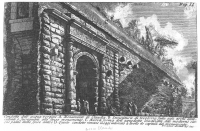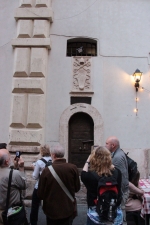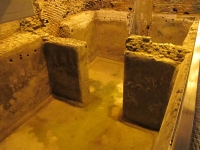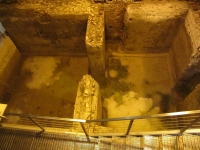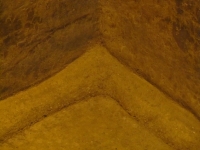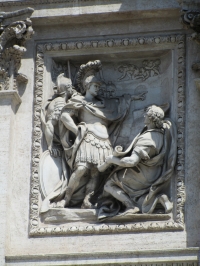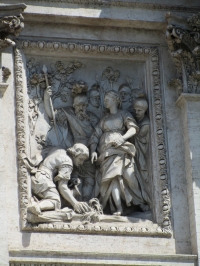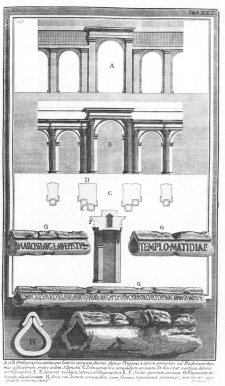Part I: Aqua Virgo
There is a great deal of literature about the 21 km long Aqua Virgo, because it is the one ancient aqueduct that remains functional within modern Rome. Fourteen years
after he built the Aqua Julia, Agrippa constructed the Aqua Virgo (19 BCE) in order to supply water to the Campus Martius, which Augustus was in the process of developing.
There are two theories with regards to the aqueduct′s name. Frontinus suggests that it was named after the young girl who discovered its source. Others, however,
believe that it was named after a statue of a water goddess housed in a temple near the source.
The Virgo′s source was positioned near Rome in a marshy area north of the Via Collatina, just before the 8th milestone. Several [subterranean] feeder channels throughout
its course augmented the Virgo′s water volume. One consequence of these channels was an influx of precipitate impurities that could impede or even obstructed its flow, and
therefore the Virgo required periodic maintenance.
The plan of the Virgo complemented that of the Julia and met the specific requirements of the districts that were poorly served by earlier aqueducts. The Virgo distributed water
to the Via Lata, Circus Flaminius, Campus Martius and Transtiberim. The service to the Transtiberim illustrates one of the main reasons for the construction of the Pons Agrippae.
The Virgo required a bridge to carry the water to the opposite side of the Tiber. Frontinus notes that the Transtiberim already received water from the Aquae Appia, Anio Vetus and
Marcia, but this supply was limited by the constraints of the delivery pipes running across the Pons Aemilius. The aqueduct was also to service Agrippa′s baths near the Pantheon
and the artificial canal near the baths, called the Euripus, and the Stagnum, an artificial lake.
The Virgo entered Rome via a circular route to the north, subsequently eliminating the difficulties of tunneling through densely inhabited areas. It terminated at the Villa Julia
and transported 100,000 m3 of water per day into Rome. All but about one kilometer of the Virgo ran underground.
Frontinus suggests that little of the Virgo′s volume was allocated for private use, only about 15%. This seems plausible because of its distribution to the Campus Martius
that was primarily a non-residential area. Certainly, some of the water was intended for Agrippa′s public bath near the Pantheon. It also supplied an artificial stream near
the baths named the Euripus (Aicher 1995:39). About 22% of the Virgo′s capacity was used for buildings in the Campus Martius and Transtiberim, including warehouses and
industrial zones along the Tiber. Its limited service to the Transtiberim probably indicates that the water was used for public means and not as a luxury for private dwellings.
The remaining 63% of the water was distributed for ′usibus publici′.
The Virgo′s water was apparently quite cold and pure, according to Seneca and Martial. Seneca refers to it as pleasant water to bathe in, while Martial twice mentions its coldness.
Cassiodorus (Var. 7.6) says:
"The Aqua Virgo runs with delightful purity, for while other waters during excessive rains are invaded by earthy matter, the Virgo′s current runs pure as a never-clouded sky".
From E.J. Dembskey: The aqueducts of Ancient Rome (master thesis 2009)
Part II: Acqua Vergine
Over the years, the last, elevated stretch of Aqua Virgo stopped working. So by the late Middle Ages, the aqueduct′s outlet was no longer to be found by the ancient baths of Agrippa,
but about 1000 m before reaching the Pantheon, on a spot where, according to some historical sources, stood a small fountain, that was enlarged in 1453, on the occasion of the
major restoration, sponsored by Pope Nicholas V. A further supplementary restoration (1559-70) that enabled the making of a new network of water ducts in some of Rome′s districts,
also retrieved the aqueduct′s original springs in the Salone area. Therefore, for some time the Aqua Virgo was renamed Acqua di Salone (Salone Water). But then the old name
was adopted again, in its Italian form Acqua Vergine.
In 1735, the aforesaid fountain underwent a dramatic change, being turned into one of Rome′s most famous landmarks, the Trevi Fountain, whose making took thirty years.
After its opening, the people started referring to the Acqua Vergine also with the popular name Trevi Water.
In the same period, while the making of the monument was still in progress, Benedict XIV had the aqueduct restored again, and other minor repairs were carried out under Pius VI in 1788.
Such works were usually remembered by hanging plaques, some of which are still in place.
Over the last decades of the 1800s and the 1900s, the city considerably expanded beyond its old boundaries. To meet the increased need of water, in 1932-1937 the aqueduct was doubled
by opening a second one, called Nuovo Acquedotto Vergine Elevato (New Elevated Vergine Aqueduct), with a tall water tower built near the natural springs, in order to considerably increase
the hydraulic pressure required for propulsion. Its direction partly follows the first stretch of the old aqueduct, but it then runs more straight across the central districts, reaching its
final output with a much shorter overall length of 13 km.
In 1961, due to infiltrations caused by the modern districts built over the course of the old Acqua Vergine, the water of the ancient aqueduct was found to be polluted and was declared
no longer drinkable, being used ever since only for the main fountains in the historical districts.
From: Andrea Pollett: Roman monographs - Aqueducts part 3: Aqua Virgo / Acqua Vergine, see website
|
In short / Special characteristics
- Still in use today; it is to say: water from the same source area (Salone) and since 1937 also in metal pipes
- Water sources : mainly subterranean plus extra subterranean supply en-route
- Virgo′s course: along the Via Collatina plus a huge detour around the north, probably because of juridical (expropriation), geological (soil types) and technological (over 35 m deep tunnel necessary)
problems. In the present course also a channel is present, over 30 m below the surface. For a major part the Aqua Virgo is subsurface, apart from a part in the area of Pietralata and below the Pincio
towards the Campus Martius (both on substructions and arcades). The last part was on 139 arches, and over 1036 m in length and 9 meters high.
- The Aqua Virgo had a very modest gradient (0.013 %)
- Major purpose: to stimulate city′s development of the Campus Martius, including the Baths of Agrippa, the Stagnum, and the Euripus
- Water channels from Republican times have been found in the area of Villa Borghese - 15 m below the present surface: (a) later added branch(es)?
- Claudius added (at least) two ornamental arches to the arcade between the Pincio and Virgo′s terminus: near the Via del Nazareno (still present) and over the Via Lata (now: Via del Corso).
- In Hadrian′s time a branch was added at the foot of the Pincio, with after the first 100 m a piscina limaria [settling] basin of which only a drawing, a short description and some remains in the Vicolo del Bottino are left
- The Aqua Virgo underwent many restorations, in antiquity as well as in ′modern′ times - although its mainly subterranean course. This is probably caused by a too abundant inflow of water, not foreseen during its initial construction
- After the arcades in the Campus Martius fell in despair, a new terminus was made in the 7th century at the location now occupied by the Trevi Fountain (in its present form a structure from the 18th century)
|
History
| 19 BCE |
Festive opening of the 6th aqueduct of Rome, the Aqua Virgo, built by Agrippa in order to develop the Campus Martius |
| 17, 35-37 BC |
Restorations by Tiberius |
| 45 or 46 |
Restorations by Claudius, later adding two ornamental arches |
| 125 ?? |
Hadrian adds a branch plus a piscina limaria (settling basin) at the foot of the Pincio |
| 4th c |
Restorations by Constantine (Giannitrapani 2013), see CIL 6.31564 |
| 537 |
Procopius reports that Belisarius cuts the aqueducts (not irreparable) to prevent the Goths to enter the city during their siege of Rome (Procopius, Wars 6.9.1) |
| 8th c |
Arcades in the Campus Martius in despair |
| 774-786 |
Refurbishments by Hadrian I of some of Rome′s aqueducts (Aquae Virgo, Claudia, Traiana, Alexandrina, and Antoniniana) and a new terminus near the present Piazza di Trevi (at the east side of the Via dei Crociferi) |
| ====== |
|
| 1363 |
City of Rome declaration about the maintenance of the Aqua Virgo (Karmon 2005, 4) |
| 1453 |
Pope Nicolas V - which means: his architect / engineer Leon Battista Alberti - restores again the Aqua Virgo, enlarges the terminal fountain in the Piazza dei Crociferi with three openings. Its Italian name: Acqua Vergine |
| 1534-49 |
Agostino Steuco advices Paul III to upgrade the Acqua Vergine. Before that Steuco searches for the original subterranean course (see Bariviera2015). No action because of political problems for the pope |
| 1550′s |
Pius IV: rivalry between architects |
| 1560-70 |
Gregorius XIII finalizes the refurbishments which were started in 1560 |
| 1587 |
Sixtus V places a mostra (a new , ornamental fountain) at the present Piazza di Trevi |
| [1585-1590] |
[Sixtus V orders the building of the Acqua Felice: after 1300 years the first new built aqueduct (compare this with the Visigoths in Spain and the new-built Reccopolis aqueduct (late 6th c CE). Its source is near the ancient sources of the Aqua Alexandrina; its terminus the present Fontana di Moses.] |
| 1643 |
Bernini orders the demolition of the old fountain of Nicolas V, in favor of a planned new one at the present Piazza di Trevi |
| 1731 |
Clemens XII appoints Nicola Salvi as architect for the new fountain |
| 1740-58 |
Benedict XIV orders further restorations on the Acqua Vergine |
| 1744 |
Inauguration of the ′Trevi-fountain′ |
| 1762 |
The Trevi fountain finished in his present form |
| 1788 |
Further repairs of the Acqua Vergine |
| 1930′s |
Construction of the Acqua Vergine Nuova |
Mysterious basin
After crossing the Muro Torto, east of the present Villa Medici and the ′Chiocciola del Pincio′, a branch was made in Hadrian′s time towards a special settling basin.
Fabretti (17th c) showed a drawing and discussed its use. Lanciani (second half 19th c) reported that the basin was still functioning as a distribution basin (sic!).
An over 125 years old gypsum model is still present in the closed Museo della Civilta Romana. Ashby (1930′s) reports the destruction of the basin during construction
work of a public cable elevator. It seems reasonable to assume that in antiquity from this basin the area west of the Pincian hill was supplied.
On the site of the ′Aqueduct Hunters′ a short film is presented, in which they made a walk upstream (!) in the Aqua Virgo / Acqua Vergine, see the web
The main channel of the Aqua Virgo brought water to the Campus Martius. After the 8th c this course was later shortened to the area of the Trevi Fountain.
|
|
